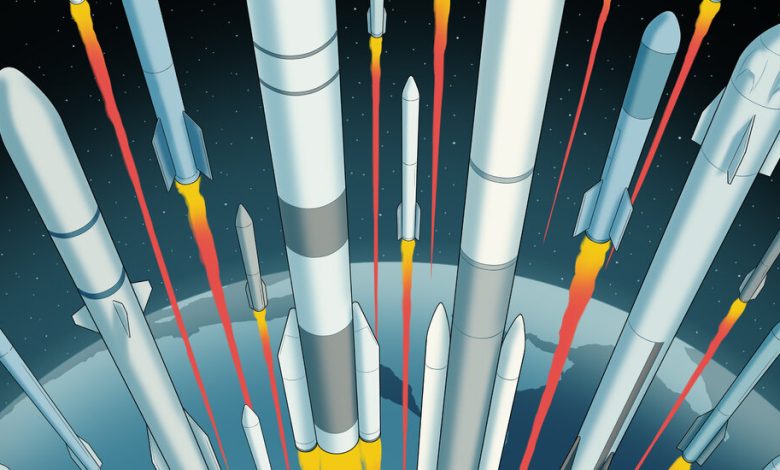The New Space Race Is Causing New Pollution Problems

The high-altitude chase started over Cape Canaveral on Feb. 17, 2023, when a SpaceX Falcon 9 rocket launched. Thomas Parent, a NASA research pilot, was flying a WB-57 jet when the rocket ascended past the right wing — leaving him mesmerized before he hit the throttle to accelerate.
For roughly an hour, Mr. Parent dove in and out of the plume in the rocket’s wake while Tony Casey, the sensor equipment operator aboard the jet, monitored its 17 scientific instruments. Researchers hoped to use the data to prove they could catch a rocket’s plume and eventually characterize the environmental effects of a space launch.
In the past few years, the number of rocket launches has spiked as commercial companies — especially SpaceX, founded by Elon Musk — and government agencies have lofted thousands of satellites into low-Earth orbit. And it is only the beginning. Satellites could eventually total one million, requiring an even greater number of space launches that could yield escalating levels of emissions.
SpaceX declined to comment about pollution from rockets and satellites. Representatives for Amazon and Eutelsat OneWeb, two other companies working toward satellite mega-constellations, said they are committed to sustainable operations. But scientists worry that more launches will scatter more pollutants in pristine layers of Earth’s atmosphere. And regulators across the globe, who assess some risks of space launches, do not set rules related to pollution.

The exhaust plume from a SpaceX Falcon 9 rocket taking off from Vandenberg Air Force Base in California in 2018,Credit…Matt Hartman/Associated Press
Experts say they do not want to limit the booming space economy. But they fear that the steady march of science will move slower than the new space race — meaning we may understand the consequences of pollution from rockets and spacecraft only when it is too late. Already, studies show that the higher reaches of the atmosphere are laced with metals from spacecraft that disintegrate as they fall back to Earth.
“We are changing the system faster than we can understand those changes,” said Aaron Boley, an astronomer at the University of British Columbia and co-director of the Outer Space Institute. “We never really appreciate our ability to affect the environment. And we do this time and time again.”
We Have Liftoff
When a rocket like the Falcon 9 lifts off, it typically takes about 90 seconds to punch through the lower atmosphere, or troposphere, before reaching the middle atmosphere. It was at the top of the troposphere that Mr. Parent began his pursuit, ultimately flying as high as the middle atmosphere, where the air’s density is so low that he and Mr. Casey had to wear pressure suits and heavyweight gloves, as well as helmets that provided them with oxygen.
The middle atmosphere has seldom seen so much excitement. Commercial airliners seldom fly at these heights. Nor is there much terrestrial weather or pollution from the ground. It is thus calm, unspoiled and empty — except for the occasional rocket, which will pass through it for three to four minutes on its way to space. By the time a rocket curves into orbit, it will have dumped in the middle and upper layers of the atmosphere as much as two-thirds of its exhaust, which scientists predict will rain down and collect in the lower layer of the middle atmosphere, the stratosphere.
The stratosphere is home to the ozone layer, which shields us from the sun’s harmful radiation. But it is extremely sensitive: Even the smallest of changes can have enormous effects on it — and the world below.
When Mount Pinatubo erupted in 1991, it belched enough sulfur dioxide gas into the stratosphere to trigger a multiyear cooling spell on Earth. That gas created sulfate aerosols, which warmed the stratosphere while blocking heat from hitting Earth’s surface. Some scientists worry that cumulative exhaust from more rockets may affect the climate in a similar manner.
Today, rocket exhaust pales in comparison to the exhaust emitted by aviation. But scientists are concerned that even small additions to the stratosphere will have a much bigger effect. Martin Ross, a scientist from The Aerospace Corporation, a federally funded research organization in Los Angeles, compared Earth’s atmosphere to a barrel of muddy water that has settled — with muck at the bottom and a relatively clear top. If you add more dirt to the mucky bottom, it may go unnoticed. But if you add that dirt to the clear top, he said, it is likely to become cloudy or even mucky.
Just how rockets will affect that relatively clear top, the stratosphere, remains uncertain. But scientists are concerned that black carbon, or soot, that is released from current rockets will act like a continuous volcanic eruption, a change that could deplete the ozone layer and affect the Earth below.
Skyrocketing Numbers
In the 1990s, when NASA’s space shuttle and other rockets consistently launched from U.S. soil, several studies predicted that the spacecraft would cause local ozone damage. One study even forecast a loss as high as 100 percent — essentially creating a small ozone hole above Cape Canaveral that would allow more of the sun’s ultraviolet radiation to reach the ground, raising the risk of skin cancer, cataracts and immune disorders.
The studies relied on models and predictions alone, with no observational data. So Dr. Ross and his colleagues gathered data from high-altitude research flights, which did find local ozone holes in the shuttle’s wake. But they healed quickly and were not large enough to affect Cape Canaveral — at least not at the frequency of launches then, roughly 25 per year.
The same may not be true going forward. In 2023, SpaceX launched nearly 100 rockets on its own, with most flights building its Starlink satellite constellation. It will soon be joined by Amazon, which is planning frequent launches for its Project Kuiper constellation, and other companies seeking substantial presences in orbit. These satellites offer a range of benefits, including broadband internet almost anywhere on Earth.
But once these companies complete their constellations of up to thousands of orbiters, the launches won’t end. Many satellites have a lifetime of five to 15 years, requiring satellite companies to loft replacements.
It is the beginning of a new era.
“I think we are at a stage in the space industry that we were at many decades ago in a number of our terrestrial environments,” said Tim Maclay, the chief strategy officer for ClearSpace, a Swiss company seeking to build sustainable space operations. “We see the prospect of development and we tend to race into it without a tremendous amount of forethought on the environmental consequences.”
A Race Against the Space Race
As space companies set records for launches and satellites deployed, scientists are starting to quantify the potential effects.
In a paper published in 2022, soot from rockets was shown to be nearly 500 times as efficient at heating the atmosphere as soot released from sources like airplanes closer to the surface. It’s the muddy-barrel effect.
“That means that as we start to grow the space industry and launch more rockets, we’re going to start to see that effect magnify very quickly,” said Eloise Marais, an associate professor in physical geography at University College London and an author of the study.
A separate study also published in 2022 found that if the rate of rocket launches increased by a factor of 10, their emissions could cause temperatures in parts of the stratosphere to rise as much as 2 degrees Celsius. This could begin to degrade the ozone over most of North America, all of Europe and a chunk of Asia.
As a result, “people at higher latitudes in the Northern Hemisphere may be exposed to more harmful ultraviolet radiation,” said the study’s lead author, Christopher Maloney of the Cooperative Institute for Research in Environmental Sciences at the University of Colorado Boulder.
That said, Dr. Maloney’s team did not quantify how much more radiation exposure could occur.
The exact amounts of soot emitted by different rocket engines used around the globe are also poorly understood. Most launched rockets currently use kerosene fuel, which some experts call “dirty” because it emits carbon dioxide, water vapor and soot directly into the atmosphere. But it might not be the predominant fuel of the future. SpaceX’s future rocket Starship, for example, uses a mix of liquid methane and liquid oxygen propellants.
Still, any hydrocarbon fuel produces some amount of soot. And even “green rockets,” propelled by liquid hydrogen, produce water vapor, which is a greenhouse gas at these dry high altitudes.
“You can’t take what’s green in the troposphere and necessarily think of it being green in the upper atmosphere,” Dr. Boley said. “There is no such thing as a totally neutral propellant. They all have different impacts.”
Smithereens of Satellites
What goes up must come down. Once satellites in low-Earth orbit reach the end of their operational lifetimes, they plunge through the atmosphere and disintegrate, leaving a stream of pollutants in their wake. Although scientists do not yet know how this will influence Earth’s environment, Dr. Ross thinks that it will be the most significant impact from spaceflight.
A study published in October found that the stratosphere is already littered with metals from re-entering spacecraft. It used the same NASA WB-57 jet that chased the SpaceX rocket plume last year, studying the stratosphere over Alaska and much of the continental U.S.
When the researchers began analyzing the data, they saw particles that didn’t belong. Niobium and hafnium, for example, do not occur naturally but are used in rocket boosters. Yet these metals, along with other distinct elements from spacecraft, were embedded within roughly 10 percent of the most common particles in the stratosphere.
The findings validate earlier theoretical work, and Dr. Boley, who was not involved in the study, argues that the percentage will only increase given that humanity is at the beginning of the new satellite race.
Of course, researchers cannot yet say how these metals will affect the stratosphere.
“That’s a big question that we have to answer moving forward, but we can’t presume that it won’t matter,” Dr. Boley said.
An Exception to the Rule
While scientists are raising the alarm, they don’t see themselves in opposition to rocket companies or satellite operators.
“We don’t want to stop the space industry,” said Karen Rosenlof, a climate scientist at the National Oceanic and Atmospheric Administration Chemical Sciences Laboratory, who says that satellites provide incredible services to people on the ground. But she and others are asking for a set of regulations that will consider the environmental implications.
Dr. Rosenlof argues that there are ways to reduce the impacts of the space industry without shutting it down. For example, if scientists find a threshold beyond which the space industry will start to harm the environment, it would make sense to simply limit the numbers of launches and satellites. Alternatively, the materials or fuels used by the space industry could be tweaked.
Dr. Boley agrees. “There are a lot of possibilities that could help us protect the environment while still giving access to space,” he said. “We just need to look at the big picture.”
But to do that, scientists argue, satellite operators and rocket companies need regulations. Few are currently in place.
“Space launch falls into a gray area,” said Gavin Schmidt, director of the NASA Goddard Institute for Space Studies, who has been involved in a working group on this research. “It falls between the cracks of all the regulatory authorities.”
The Montreal Protocol, for instance, is a treaty that successfully set limits on chemicals known to harm the ozone layer. But it does not address rocket emissions or satellites.
In the United States, the Environmental Protection Agency is not responsible for analyzing rocket launches. The Federal Communications Commission licenses large constellations of satellites but does not consider their potential harm to the environment. (The Government Accountability Office called for changes to that F.C.C. policy in 2022, but they have yet to occur.) And the Federal Aviation Administration assesses environmental impacts of rocket launches on the ground, but not in the atmosphere or space.
That could put the stratosphere’s future in the hands of Elon Musk, Jeff Bezos and other private space company executives — which is particularly worrying to Dr. Boley, who says the space industry does not want to slow down.
“Unless it immediately affects their bottom line, they’re simply not interested,” he said. “The environmental impact is an inconvenience.”
A spokesperson for the telecommunications company OneWeb, which has launched more than 600 satellites, said it is committed to sustainability in satellite design, constellation plans and launch efforts.
“We work closely with public and private partners to minimize the environmental impact of our fleet of satellites,” said Katie Dowd, a senior director there.
Still, OneWeb plans to expand its constellation to roughly 7,000 satellites.
“It remains to be seen how well we’re going to do this,” Dr. Maclay said. “We don’t tend to be very good as a species at proactively taking responsible steps toward environmental stewardship. It often comes as an afterthought.”



